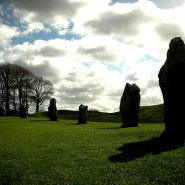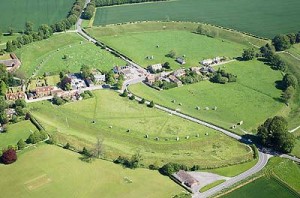The magic of Avebury

Most visitors to Britain will be familiar with the image of Stonehenge as one of the country’s most iconic landmarks that attracts thousands of visitors every year.
Not very far from Stonehenge though, is another equally impressive archaeological site that remains little visited by comparison with its more famous neighbour. The site is called ‘Avebury’ and it remains one of the most fascinating and mysterious places in the World.
Today the small village of Avebury lies nestled in the folds of the landscape of Wiltshire in Southern England, a green and generally open area of beautiful countryside. The most amazing thing about Avebury village though is that the small cluster of houses lies in the centre of an incredible circle of huge stones known as ‘megaliths’. The history of the village is thus inevitably linked to the prehistoric monuments that surround it. Abandoned for several thousand years the land around the stones became occupied once more when people of the Saxon period began to settle in the area. Their arrival and subsequent development of the present village was to have a dramatic effect on the history of the stones for this is a landscape sculpted by ancient man for purposes we can only guess at.
Around 4,500 years ago, when London was still was a thinly inhabited marshland, the area around Avebury almost certainly formed the Neolithic equivalent of a city. In Archaeological terms the site of Avebury is known as a ‘henge’ – an area that incorporates a number of incredible features including an enormous ditch, steep earth banks, huge natural stones that form both circles and linear avenues and many other archaeological curiosities like burial mounds and sacred streams. Very close to Avebury lies the equally enigmatic Silbury Hill, the largest man-made mound in Europe that today dominates the surrounding landscape as much today as it would have done throughout the centuries. If that wasn’t enough the two largest surviving British ‘long barrows’ of West Kennet and East Kennet are also to be found a short distance away and in recent years the remains of two massive enclosures have also been discovered. The whole area around Avebury therefore provides us with an amazing ‘open air museum’ that prompted the famous antiquarian John Aubrey to remark “it does as much exceed in greatness the so renowned Stonehenge as a Cathedral does a parish church”
The stone circle is thought to date from around 2600 BC which means it was already ancient at the time of the Roman Invasion of Britain. Nearby excavations at a site known as ‘Windmill Hill’ has revealed evidence of human occupation as early as 3700 BC so it is known that the area has been a centre of human activity for some 6000 years and is termed by some historians as a ‘ritual landscape’ implying that the Avebury area has been recognised from ancient times as an important and sacred location.
Although it is virtually impossible to state with any certainty why the Avebury complex was carved out of the landscape by ancient man we do know that the original circular ditch was dug out with antler picks and stone tools around 2500 BC and was originally a staggering ten metres deep. It is on the central island of land created by the ditch that the incredible megalithic stones were set into the ground but experts believe that the stones were put in place prior to the creation of the ditch around 2600BC.
The actual stones where quarried from the Marlborough Downs and transported overland, probably on wooden rollers. This must have been a monumental task as some of the stones within the circle are over 40 tons, almost twice as heavy as some of the Stonehenge stones, although not as well finished and shaped. There were originally around 100 of these stones although only 27 remain, the missing stones marked today by concrete posts.

If you visit Avebury today it is probably the size of the stones that leaves a lasting impression but when the circle was first constructed the most awesome feature must have been the ditch and bank which had been dug from the solid chalk of the Wiltshire landscape. Excavations have revealed that, due to erosion and silting, the ditch today is now only one third of its original depth and the bank much reduced in height.
The stone circle and henge that surround the village is only one of a series of ancient monuments that are concentrated in a relatively small area of Wiltshire that archaeologists refer to as a ‘ritual Neolithic landscape’. When in full use around 4000 years ago the Avebury complex must have been a truly awe inspiring place.
Sadly a lot of destruction of the Avebury site took place during the 17th and 18th centuries when ‘puritanical’ religious beliefs viewed the stones as ‘pagan’ and therefore evil. It was at this time that a lot of the stones were destroyed although fortunately a lot of drawings and engravings exist which depict the original site in its former glory.
As with all ancient sites a certain mythology or folklore is attached to certain stones and visitors to this site today are still shown features like the ‘Devil’s chair’, a natural seat where wishes can be made or childless couples can sit in the hope that pregnancy will soon follow! Other stories abound of stones moving in the dead of night accompanied by mysterious lights.
Like most ancient sites there is also a strong connection to Astronomy and indeed many of the stones not only align to particular stars but also align to other ancient features of the landscape and research continues to this day into such topics.
Whether you are a historian, archaeologist, astronomer or just a tourist though, one thing is certain. Avebury exudes an undeniable atmosphere that almost everyone can sense when they visit this amazing place. It is a sense or wonderment and awe at the achievements of our ancestors mixed with a sense of the sacred and special.
Truly, for young and old alike, Avebury is a very magical place to visit if you are ever fortunate enough to get the opportunity.
Author: R A Gear



